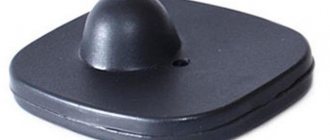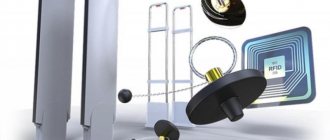An anti-theft magnet on clothing protects goods from thieves. After all, it’s unfair that someone pays for a fashionable item, and someone wears it just like that. If unpaid clothes are brought through the turnstile, the system will notify sellers and security about the incident. This is a reasonable precaution on the part of the store.
But there are times when the legal owner of a fashionable look cannot wear his purchase. Sometimes the seller forgets to remove the anti-theft protection. And, as luck would have it, it is at this moment that the turnstile is silent. Mistakes happen to everyone, but you don’t want to go to the other end of town to remove the protection because of someone else’s mistake. Besides, how to remove a store magnet from clothes if the receipt is missing? After all, seasonal items can lie in the closet for a week, a month, six months. Nobody keeps receipts for that long, and the writing on the receipt tape quickly fades. You won’t ask to look through all the records to establish the fact of the purchase. It’s much more rational to think about how to remove store magnets from clothes at home.
What is a magnetic tag?
Surely, during any fitting of clothes, you paid attention to the large black or white clip. This is a magnetic tag. In addition to the name we are familiar with, it also has several implications: just a magnet, a tag, a beeper, since it gives a signal. Also, a magnetic tag is often called an alarm (from English - alarm), adjacent to a military signal. Popularly this is an anti-theft sensor and “anti-theft”. Hence its purpose - it is attached to an item in order to prevent theft and damage to clothing in a store.
Device design
Most often, there are four types of sensors in clothing stores.
Flat "Pencil"
Such safety devices provide puncture-free fastening. The mechanism is equipped with a long lever. The clothing pin snaps into the cap so there is no need to pierce the material. These devices are ideal for preventing theft of swimsuits, scarves and underwear made from delicate materials. “Pencil” is produced with a length of about 48 mm and a diameter of about 10 mm.
Super tag sensor
A special feature of this device is a mechanical lock. The sensor can only be dismantled using a special manual or automatic removable device. It is attached to the product using a special needle with a wide plastic cap. Size 70×30 mm and 55×30 mm.
Square "Mini Squire"
A flat device with a small protruding part. The Mini Squire anti-theft sensor is designed so that this form of the device does not interfere with the buyer trying on clothes. An additional hole allows you to use a steel cord and hang the device from belt loops or other parts. This sensor is only available in RF version. Size 48x42 mm, weight about 6 g. Reliable and inexpensive.
"Shell" (golf)
Designed for more durable materials. The ultra-thin rod easily penetrates the fabric without leaving marks. Another advantage is ease of use. The “shell” fastening pin allows you to easily fix the device with one hand. When using these devices, employee productivity increases noticeably, as time spent on marking is reduced. There are 3 main sizes on the market: 45 mm, 54 mm, and 63 mm in diameter.
Types of tags
Despite the large number of names and variants of beepers, but paying attention to the principle of operation, they can be divided into several groups.
First group
This includes small devices that are triggered by radar gates that are located at the exit door. In appearance, these are plates that are tuned to the frequency of the touch antenna (8 MHz). And their name is radio tags.
Second group
These are small plastic stickers that work even when cut. Such stickers are attached to small-sized products.
Third group
These include magnetic-acoustic anti-theft sensors. They are a plastic clip with a sharp metal rod. The peculiarity of these tags is that with physical pressure, both sides can close even more tightly. They also have a built-in capsule with neon dye, which can ruin the clothes if stolen.
Fourth group
This includes all electromagnetic sensors.
Radio frequency and acoustomagnetic sensors are most popular and used in the trade sector. They are practical, reliable and provide good protection against theft.
Now we can reveal the secret of why a magnetic tag, as it is often called, is not actually one. Information about how the beeper mechanism itself works will help us find out about this. Let's consider the internal contents of the used tag.
Production technology of anti-theft devices
Anti-theft devices consist of three main components:
- a sensor that is connected to an emergency warning system through a certain type of signal;
- pins or magnet;
- locking mechanism.
Reusable rigid devices, which are most often used to protect textile products, are made of impact-resistant plastic. The pin for attaching the device to the product is made of nickel-plated steel.
The plastic body is cast by vacuum molding or under pressure. The resonator is a coil of insulated copper wire, the ends of which are connected through a diode. After the resonator is inserted into the plastic housing, the locking mechanism is installed. It usually consists of a coupling that secures a metal pin.
Once the resonator and coupling assemblies are in place, the top and bottom parts of the housing are joined together. They are sealed by heating or welded ultrasonically
What does an RF tag look like?
In addition to the device of the tag, you can talk about the so-called “bottle sensor”. Among RF beepers, it is widely used in retail industry. Its demand is explained by its adequate cost, ease of use, and it can be purchased without problems. The bottle tag is distinguished by its stylish appearance: two clips, one of which has a bulge that resembles a bottle. In addition, it has a different type of fastening - an adjustable cable that connects the sensor and the product.
Having understood the types and operation of tag mechanisms, you can move on to the part of the article that talks about how to remove a magnet from clothes in a store and at home yourself.
History of anti-theft systems
The products first appeared on the market in 1966. Today, security sensors have become so popular that annual revenue from the sale of devices amounts to billions of dollars.
For the first 20 years of anti-theft devices' existence, radio frequency technology was used. A semiconductor diode was used to relay the high-frequency radio signal from the detection antennas. In most cases, the alarm was triggered, but the capabilities of this technique were still limited. For example, older devices could be defeated by placing goods in a foil bag, which blocked the signal. In addition, due to the widely spaced entrance gates, false alarms occurred.
In the mid-80s of the last century, acoustomagnetic technology was developed. These emergency alert systems work with low-frequency radio waves that cannot be blocked by metal foil. The sensors contain coils of suitably magnetized metal that resonate in response to a signal. Although these types of systems are slightly more expensive than their predecessors, the cost is recouped through reliable operation.
Anti-theft sensors are standard security in most clothing stores. In the past, appliances were large and bulky, as were the pins that could easily damage the fabric, leaving holes in the material. Modern devices are designed in such a way that coupling and detaching are carried out delicately, without causing damage to clothing.
How to remove a tag in a store?
To remove tags in stores, there are special removers called deactivators. They are automatic, mechanical and magnetic. It is the latter that are more in demand, as they are suitable for deactivating acoustomagnetic and radio frequency tags.
Magnetic pullers are very compact, easy to use, and can be easily changed location. Another plus is that they are invisible to both the buyer and the seller.
However, there are situations when a buyer, bringing a new item home, noticed that the cashier forgot to remove the magnetic tag, or there were several of them. What to do in such cases and how to remove the tag from clothes at home - you will find out below.
Hard sensor - additional advertising
Stores use anti-theft hard detectors for clothing only as property protection. Manufacturers have expanded the scope of application of devices, adding the ability to use the device as an advertising medium. The logo of the clothing brand, discounts and promotional offers, and other advertising messages are applied to the surface of the device.
How to remove anti-theft at home without special tools?
There are many ways to solve this problem on the Internet. Let's focus only on proven ones. We will move from simple methods to more sophisticated ones.
Method No. 1
You will need a regular hair tie.
To remove a magnet from clothes, you need to do this:
- Take a thin hair elastic.
- We place it between the convex part of the sensor and the clothing.
- Next, we twist this convex part in different directions so that the elastic fits tightly and secures. When the elastic is at the junction of the two parts of the tag, slowly disconnect these parts from each other until they fall off.
Important! You must act delicately and calmly so as not to tear your clothes.
Method No. 2
In this case, add regular pliers to the elastic band.
The algorithm for removing a magnetic tag from clothing at home is as follows:
- When you have placed the elastic, as in method No. 1, we break the convex part of the tag with pliers.
- We open the cavity of the object.
- Take out the dye capsule.
Important! In the first two methods, an elastic band is needed to prevent damage to the clothes. Also, when it hits the joint between two parts, it loosens faster and the tag is easier to remove.
Method No. 3
In this case, you will need tongs and a candle or lighter.
They are used like this:
- We hold the top part of the “anti-theft” over the fire until it begins to melt a little.
- Use tongs to carefully open the case.
- We take out all the internal parts.
After such manipulations, the clip will open on its own.
Method No. 4
For this method you will need a hammer and a refrigerator.
It works like this:
- We freeze clothes with an alarm.
- After a while, we take it out and hit the clip with a hammer.
- We carefully disassemble the tag.
Important! There is another option - we throw the frozen sensor on a concrete floor. This method requires the use of good physical strength.
Method No. 5
Involves the use of one tool - wire cutters. To remove a tag from clothing:
- We take wire cutters.
- Open half of the tag.
- We remove the protective mechanism.
Method No. 6
Well suited to alarms, which are called “bottle alarms”. Using a suitable tool - a knife or nail file, we cut the sensor.
Important! We saw, or rather, cut, this particular bottle.
Method No. 7
We buy a neodymium device, that is, a magnet with strong power, and attach it to the anti-theft clip.
Important! Some tag removal methods involved freezing the clothing. Indeed, it is not entirely clear how the paint capsule will behave. Therefore, it is best to play it safe and freeze the alarm, regardless of the removal method.
If you, having come home and thought about how to deal with this issue, still do not risk removing the tag yourself, that’s okay. Employees of the store where the item was purchased, if they have a receipt and an explanation of the problem, will easily remove the sensor.
Share on social media networks:
Removing a Security Sensor
When selling a product, the hard anti-theft sensor must be removed from the product in order to be reused in the future. This process occurs using a mechanical device or a powerful magnet. The puller releases the locking mechanism and allows you to remove the safety sensor. Install it on the counter in the checkout area.
Flexible security tags are deactivated by a scanner at the time of payment to the buyer. During the deactivation process, the circuit inside the tag is broken. After this, it no longer emits a signal near the antenna and does not set off the alarm. Labels cannot be reused.
Use dish soap
photo: Featurepics stock
Oddly enough, ordinary dishwashing liquid like “Fairy” works well with sticker glue.
The product is applied to the glue and left on the fabric for several hours. If everything worked out, then after a couple of hours you will see that the glue has softened; new clothes can be thrown into the washing machine (or washed by hand) to finally remove the glue from the fabric.
see also
25 life hacks for every day for those who stay at home
What if you travel far or don’t have a receipt?
But perhaps you have already thrown away the receipt, or maybe you even bought a new thing while on vacation in another city or country, or you don’t want to go to the other end of the city for this ill-fated magnet.
Questions and Answers Will you be denied a discount if you forgot your store discount card at home?
Then you should try going to the nearest shopping center and telling your story. Of course, if you have a receipt in your hands, cashier salespeople will be more willing to help. But it is possible that even if you have a receipt, the store’s internal regulations prohibit them from removing magnets from “other people’s” things. It may also be that their deprotection device does not fit your particular magnet. You can, of course, contact not one, but several nearby stores.
How to remove price tag marks on clothes?
You need to heat the label with a hairdryer, carefully, after prying up the edge, remove
her. Then treat the area with a cloth moistened with nail polish remover, but without acetone, which can damage the surface.
Interesting materials:
What adhesive should I use for gypsum tiles? What kind of rug should I put on the bathroom floor? What starch is used for jelly? What starch is used to make milk jelly? What starch is needed for jelly? What dye should I use for icing? What coloring should I use for the biscuits? What kind of paint can be used to paint stones? What paint can be used to paint a varnished surface? What kind of paint can you use to paint the lining at your dacha?











